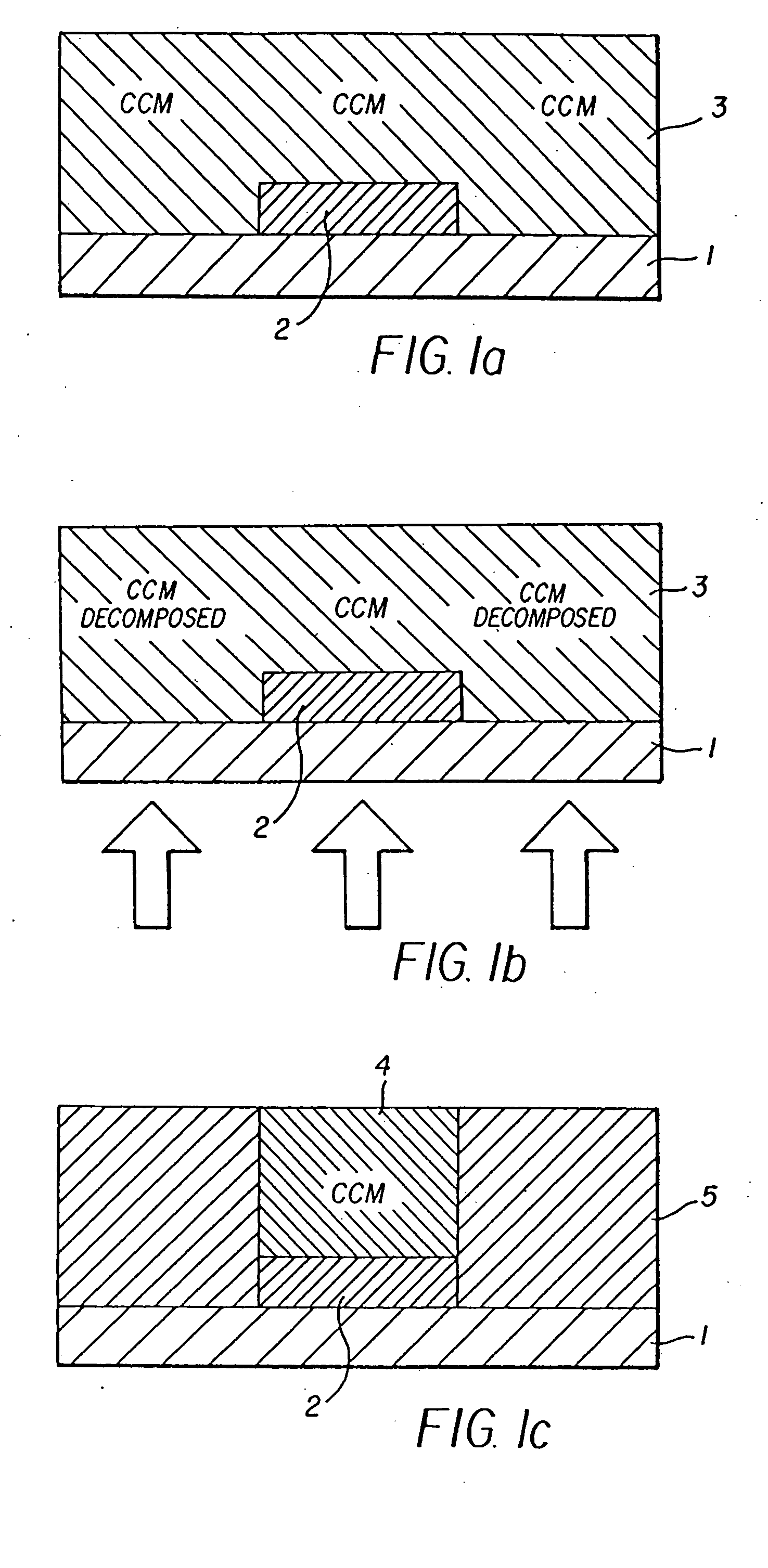Color-converting filter and manufacturing method
a technology of color-converting filters and manufacturing methods, which is applied in the direction of identification means, natural mineral layered products, instruments, etc., can solve the problems of pattern shape reproducibility and pattern deformation during subsequent manufacturing steps, drop in efficiency due to so-called concentration quenching, and decomposition of color-converting colorants, so as to simplify the driving circuitry of light sources, shorten the manufacturing process, and reduce the effect of labor intensity
- Summary
- Abstract
- Description
- Claims
- Application Information
AI Technical Summary
Benefits of technology
Problems solved by technology
Method used
Image
Examples
example 1
[0079] A blue filter material (Color Mosaic CB-7001 made by Fujifilm Arch Co., Ltd.) was applied using a spin coating method onto transparent glass substrate 1, and patterning was carried out using a photolithography method, thus forming blue color filter layers 2B of thickness 2 μm in a pattern of lines running in a longitudinal direction with a line width of 0.1 mm and a line spacing of 0.33 mm.
[0080] A green filter material (Color Mosaic CG-7001 made by Fujifilm Arch Co., Ltd.) was applied using a spin coating method onto the transparent glass substrate 1 on which blue color filter layers 2B had been formed, and then patterning was carried out using a photolithography method, thus forming green color filter layers 2G of thickness 2 μm in a pattern of lines running in the longitudinal direction with a line width of 0.1 mm and a line spacing of 0.33 mm.
[0081] A red filter material (Color Mosaic CR-7001 made by Fujifilm Arch Co., Ltd.) was applied using a spin coating method, and ...
example 2
[0085] A black mask material (Color Mosaic CK-7000 made by Fujifilm Arch Co., Ltd.) was applied using a spin coating method onto transparent substrate 1, and then patterning was carried out using a photolithography method, thus obtaining black mask 6 of thickness 1.5 μm having therein a plurality of openings each of size 0.33 mm (longitudinal direction)×0.09 mm (transverse direction). The spacing between the openings was 0.03 mm in both the longitudinal and transverse directions.
[0086] Next, a blue filter material (Color Mosaic CB-7001 made by Fujifilm Arch Co., Ltd.) was applied using a spin coating method, and patterning was carried out using a photolithography method, thus forming blue color filter layers 2B of thickness 2 μm in a pattern of lines running in the longitudinal direction with a line width of 0.1 mm and a line spacing of 0.33 mm.
[0087] A green filter material (Color Mosaic CG-7001 made by Fujifilm Arch Co., Ltd.) was applied using a spin coating method onto the tra...
example 3
[0095] The present example is for illustrating the effects of colorant layer 3 used in the third embodiment of the present invention. Amounts of 0.05 g of Coumarin 6 and 0.04 g of Rhodamine B were added to 25 g of a photoresist V259PAP5 (made by Nippon Steel Chemical Co., Ltd.), thus obtaining a coating liquid. The coating liquid was applied to the surface of a transparent substrate (a 1737 glass substrate made by Corning), thus obtaining a colorant layer of thickness 2 μm.
[0096] Next, using a sputtering method, a gas barrier layer comprising an SiO2 film of thickness 0.5 μm was formed such as to cover the colorant layer, thus obtaining a colorant layer substrate. An RF planar magnetron type apparatus was used as the sputtering apparatus, SiO2 was used as the target, and Ar was used as the sputtering gas. The substrate temperature during the SiO2 film formation was set to 80° C.
[0097] An anode (a multi-layered body of Al of thickness 500 nm and ITO of thickness 100 nm), an organic...
PUM
| Property | Measurement | Unit |
|---|---|---|
| thickness | aaaaa | aaaaa |
| thickness | aaaaa | aaaaa |
| wavelength | aaaaa | aaaaa |
Abstract
Description
Claims
Application Information
 Login to view more
Login to view more - R&D Engineer
- R&D Manager
- IP Professional
- Industry Leading Data Capabilities
- Powerful AI technology
- Patent DNA Extraction
Browse by: Latest US Patents, China's latest patents, Technical Efficacy Thesaurus, Application Domain, Technology Topic.
© 2024 PatSnap. All rights reserved.Legal|Privacy policy|Modern Slavery Act Transparency Statement|Sitemap



